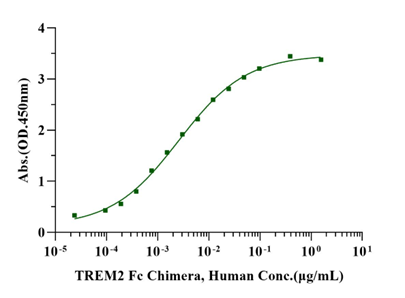His19-Ser174, with C-terminal Human IgG1 Fc HNTTVFQGVAGQSLQVSCPYDSMKHWGRRKAWCRQLGEKGPCQRVVSTHNLWLLSFLRRWNGSTAITDDTLGGTLTITLRNLQPHDAGLYQCQSLHGSEADTLRKVLVEVLADPLDHRDAGDLWFPGESESFEDAHVEHSISRSLLEGEIPFPPTSIEGRMDPKSSDKTHTCPPCPAPELLGGPSVFLFPPKPKDTLMISRTPEVTCVVVDVSHEDPEVKFNWYVDGVEVHNAKTKPREEQYNSTYRVVSVLTVLHQDWLNGKEYKCKVSNKALPAPIEKTISKAKGQPREPQVYTLPPSRDELTKNQVSLTCLVKGFYPSDIAVEWESNGQPENNYKTTPPVLDSDGSFFLYSKLTVDKSRWQQGNVFSCSVMHEALHNHYTQKSLSLSPGK
1. Deczkowska A, Weiner A, Amit I. The physiology, pathology, and potential therapeutic applications of the TREM2 signaling pathway. Cell. (2020) 181:1207-17. 10.1016/j.cell.2020.05.003 2. Guerreiro R, Wojtas A, Bras J, Carrasquillo M, Rogaeva E, Majounie E, et al.. TREM2 variants in Alzheimer's disease. N Engl J Med. (2013) 368:117-27. 10.1056/NEJMoa1211851 3. Molgora M, Esaulova E, Vermi W, Hou J, Chen Y, Luo J, et al.. TREM2 modulation remodels the tumor myeloid landscape enhancing Anti-PD-1 immunotherapy. Cell. (2020) 182:886-900.e817. 10.1016/j.cell.2020.07.013.
Triggering receptor expressed on myeloid cells-2 (TREM2) is a transmembrane receptor of the immunoglobulin superfamily and a crucial signaling hub for multiple pathological pathways that mediate immunity. Expressed in the brain, specifically in microglia and in the fusiform gyrus. TREM2 can inhibit the phagocytic function of dendritic cells and macrophages, thereby affecting related immune signaling pathways. TREM2 has vital roles in Alzheimer's disease and other neurodegenerative diseases, and is involved in numerous immune and inflammatory pathways that contribute to the etiology of these diseases. TREM2 has been studied widely in microglia, where TREM2 functions in neuronal debris clearance to counteract the inflammatory response. TREM2 can alter the morphology of tumor-infiltrating macrophages, inhibit tumor growth, and enhance checkpoint blocking therapy. TREM2 can function as a prognostic marker in various malignant tumors because of its role in tumorigenesis and tumor immunity.

1μg (R: reducing conditions, N: non-reducing conditions).

Immobilized Apolipoprotein E/APOE4 His Tag, Human (Cat. No. UA030062) at 2.0μg/mL (100μL/well) can bind TREM2 Fc Chimera, Human (Cat. No. UA010593) with EC50 of 2.08-3.22ng/ml.